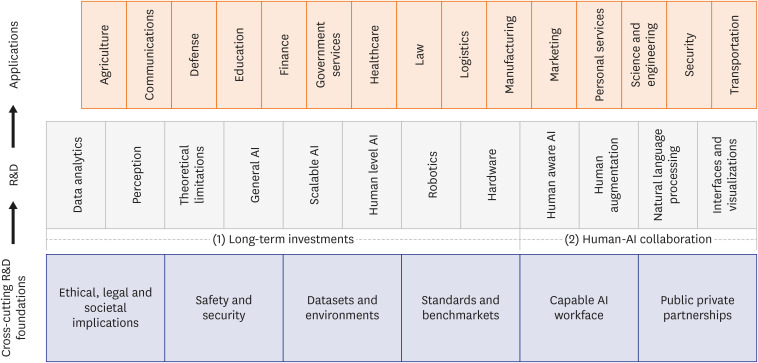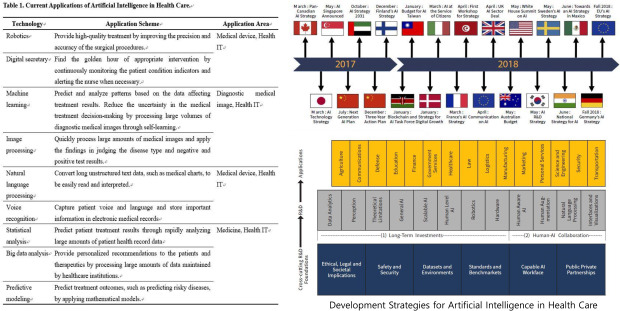1. Rajkomar A, Dean J, Kohane I. Machine learning in medicine. N Engl J Med. 2019; 380(14):1347–1358. PMID:
30943338.

2. Shimizu H, Nakayama KI. Artificial intelligence in oncology. Cancer Sci. 2020; 111(5):1452–1460. PMID:
32133724.

3. Obermeyer Z, Emanuel EJ. Predicting the future - big data, machine learning, and clinical medicine. N Engl J Med. 2016; 375(13):1216–1219. PMID:
27682033.

4. Jiang F, Jiang Y, Zhi H, Dong Y, Li H, Ma S, et al. Artificial intelligence in healthcare: past, present and future. Stroke Vasc Neurol. 2017; 2(4):230–243. PMID:
29507784.

5. Cruz JA, Wishart DS. Applications of machine learning in cancer prediction and prognosis. Cancer Inform. 2007; 2:59–77. PMID:
19458758.

6. Ryu SM, Seo SW, Lee SH. Novel prognostication of patients with spinal and pelvic chondrosarcoma using deep survival neural networks. BMC Med Inform Decis Mak. 2020; 20(1):3. PMID:
31907039.

7. Pesapane F, Codari M, Sardanelli F. Artificial intelligence in medical imaging: threat or opportunity? Radiologists again at the forefront of innovation in medicine. Eur Radiol Exp. 2018; 2(1):35. PMID:
30353365.

8. Ting DS, Cheung CY, Lim G, Tan GS, Quang ND, Gan A, et al. Development and validation of a deep learning system for diabetic retinopathy and related eye diseases using retinal images from multiethnic populations with diabetes. JAMA. 2017; 318(22):2211–2223. PMID:
29234807.

9. Han I, Kim JH, Park H, Kim HS, Seo SW. Deep learning approach for survival prediction for patients with synovial sarcoma. Tumour Biol. 2018; 40(9):1010428318799264. PMID:
30261823.

10. Lee J, An JY, Choi MG, Park SH, Kim ST, Lee JH, et al. Deep learning-based survival analysis identified associations between molecular subtype and optimal adjuvant treatment of patients with gastric cancer. JCO Clin Cancer Inform. 2018; 2(2):1–14.

11. Kim JK, Choi MJ, Lee JS, Hong JH, Kim CS, Seo SI, et al. A Deep Belief Network and Dempster-Shafer-Based Multiclassifier for the Pathology stage of prostate cancer. J Healthc Eng. 2018; 2018:4651582. PMID:
29755715.

12. The Lancet. Artificial intelligence in health care: within touching distance. Lancet. 2018; 390(10114):2739. PMID:
29303711.
13. Kelly CJ, Karthikesalingam A, Suleyman M, Corrado G, King D. Key challenges for delivering clinical impact with artificial intelligence. BMC Med. 2019; 17(1):195. PMID:
31665002.

14. Erickson BJ, Korfiatis P, Akkus Z, Kline TL. Machine learning for medical imaging. Radiographics. 2017; 37(2):505–515. PMID:
28212054.

15. Hu W, Cai B, Zhang A, Calhoun VD, Wang YP. Deep collaborative learning with application to the study of multimodal brain development. IEEE Trans Biomed Eng. 2019; 66(12):3346–3359. PMID:
30872216.

16. Patel V, Armstrong D, Ganguli M, Roopra S, Kantipudi N, Albashir S, et al. Deep learning in gastrointestinal endoscopy. Crit Rev Biomed Eng. 2016; 44(6):493–504. PMID:
29431094.

17. Komura D, Ishikawa S. Machine learning approaches for pathologic diagnosis. Virchows Arch. 2019; 475(2):131–138. PMID:
31222375.

18. Currie G, Hawk KE, Rohren E, Vial A, Klein R. Machine learning and deep learning in medical imaging: intelligent imaging. J Med Imaging Radiat Sci. 2019; 50(4):477–487. PMID:
31601480.

19. Gulshan V, Peng L, Coram M, Stumpe MC, Wu D, Narayanaswamy A, et al. Development and validation of a deep learning algorithm for detection of diabetic retinopathy in retinal fundus photographs. JAMA. 2016; 316(22):2402–2410. PMID:
27898976.

20. Ting DS, Pasquale LR, Peng L, Campbell JP, Lee AY, Raman R, et al. Artificial intelligence and deep learning in ophthalmology. Br J Ophthalmol. 2019; 103(2):167–175. PMID:
30361278.

21. Park HJ, Kim SM, La Yun B, Jang M, Kim B, Jang JY, et al. A computer-aided diagnosis system using artificial intelligence for the diagnosis and characterization of breast masses on ultrasound: added value for the inexperienced breast radiologist. Medicine (Baltimore). 2019; 98(3):e14146. PMID:
30653149.
22. Kim K, Kim S, Lee YH, Lee SH, Lee HS, Kim S. Performance of the deep convolutional neural network based magnetic resonance image scoring algorithm for differentiating between tuberculous and pyogenic spondylitis. Sci Rep. 2018; 8(1):13124. PMID:
30177857.

23. Topol EJ. High-performance medicine: the convergence of human and artificial intelligence. Nat Med. 2019; 25(1):44–56. PMID:
30617339.

24. Mori Y, Kudo SE, Misawa M, Saito Y, Ikematsu H, Hotta K, et al. Real-time use of artificial intelligence in identification of diminutive polyps during colonoscopy: a prospective study. Ann Intern Med. 2018; 169(6):357–366. PMID:
30105375.
25. Soffer S, Ben-Cohen A, Shimon O, Amitai MM, Greenspan H, Klang E. Convolutional neural networks for radiologic images: a radiologist's guide. Radiology. 2019; 290(3):590–606. PMID:
30694159.

26. Fischer AM, Varga-Szemes A, Martin SS, Sperl JI, Sahbaee P, Neumann D, et al. Artificial intelligence-based fully automated per lobe segmentation and emphysema-quantification based on chest computed tomography compared with global initiative for chronic obstructive lung disease severity of smokers. J Thorac Imaging. 2020; 35(Suppl 1):S28–34. PMID:
32235188.

29. Hannun AY, Rajpurkar P, Haghpanahi M, Tison GH, Bourn C, Turakhia MP, et al. Cardiologist-level arrhythmia detection and classification in ambulatory electrocardiograms using a deep neural network. Nat Med. 2019; 25(1):65–69. PMID:
30617320.

30. Vahlsing T, Delbeck S, Leonhardt S, Heise HM. Noninvasive monitoring of blood glucose using color-coded photoplethysmographic images of the illuminated fingertip within the visible and near-infrared range: opportunities and questions. J Diabetes Sci Technol. 2018; 12(6):1169–1177. PMID:
30222001.

31. Fernández-Caramés TM, Froiz-Míguez I, Blanco-Novoa O, Fraga-Lamas P. Enabling the internet of mobile crowdsourcing health things: a mobile fog computing, blockchain and IoT based continuous glucose monitoring system for diabetes mellitus research and care. Sensors (Basel). 2019; 19(15):E3319. PMID:
31357725.

33. Dankwa-Mullan I, Rivo M, Sepulveda M, Park Y, Snowdon J, Rhee K. Transforming diabetes care through artificial intelligence: the future is here. Popul Health Manag. 2019; 22(3):229–242. PMID:
30256722.

36. Ahmed MR, Zhang Y, Feng Z, Lo B, Inan OT, Liao H. Neuroimaging and machine learning for dementia diagnosis: recent advancements and future prospects. IEEE Rev Biomed Eng. 2019; 12:19–33. PMID:
30561351.

37. Kim JP, Kim J, Park YH, Park SB, Lee JS, Yoo S, et al. Machine learning based hierarchical classification of frontotemporal dementia and Alzheimer's disease. Neuroimage Clin. 2019; 23:101811. PMID:
30981204.

38. Beccaria M, Mellors TR, Petion JS, Rees CA, Nasir M, Systrom HK, et al. Preliminary investigation of human exhaled breath for tuberculosis diagnosis by multidimensional gas chromatography - time of flight mass spectrometry and machine learning. J Chromatogr B Analyt Technol Biomed Life Sci. 2018; 1074-1075:46–50.

39. Long NP, Jung KH, Yoon SJ, Anh NH, Nghi TD, Kang YP, et al. Systematic assessment of cervical cancer initiation and progression uncovers genetic panels for deep learning-based early diagnosis and proposes novel diagnostic and prognostic biomarkers. Oncotarget. 2017; 8(65):109436–109456. PMID:
29312619.

42. Hripcsak G, Duke JD, Shah NH, Reich CG, Huser V, Schuemie MJ, et al. Observational health data sciences and informatics (OHDSI): opportunities for observational researchers. Stud Health Technol Inform. 2015; 216:574–578. PMID:
26262116.
44. Azencott CA. Machine learning and genomics: precision medicine versus patient privacy. Philos Trans A Math Phys Eng Sci. 2018; 376(2128):20170350. PMID:
30082298.

45. Mooney SJ, Pejaver V. Big data in public health: terminology, machine learning, and privacy. Annu Rev Public Health. 2018; 39(1):95–112. PMID:
29261408.

46. Kayaalp M. Patient privacy in the era of big data. Balkan Med J. 2018; 35(1):8–17. PMID:
28903886.

47. Sajid A, Abbas H. Data privacy in cloud-assisted healthcare systems: state of the art and future challenges. J Med Syst. 2016; 40(6):155. PMID:
27155893.

48. You SC, Lee S, Cho SY, Park H, Jung S, Cho J, et al. Conversion of National Health Insurance Service-national sample cohort (NHIS-NSC) database into observational medical outcomes partnership-common data model (OMOP-CDM). Stud Health Technol Inform. 2017; 245:467–470. PMID:
29295138.
49. Aldeen YA, Salleh M, Razzaque MA. A comprehensive review on privacy preserving data mining. Springerplus. 2015; 4(1):694. PMID:
26587362.

50. Lee J, Sun J, Wang F, Wang S, Jun CH, Jiang X. Privacy-preserving patient similarity learning in a federated environment: development and analysis. JMIR Med Inform. 2018; 6(2):e20. PMID:
29653917.

51. Tariq RA, Hackert PB. Patient Confidentiality. Treasure Island, FL: StatPearls Publishing LLC.;2020.
52. Pipersburgh J. The push to increase the use of EHR technology by hospitals and physicians in the United States through the HITECH Act and the Medicare incentive program. J Health Care Finance. 2011; 38(2):54–78. PMID:
22372032.
53. John B. Are you ready for general data protection regulation? BMJ. 2018; 360:k941. PMID:
29500167.

54. Pelayo S, Bras Da Costa S, Leroy N, Loiseau S, Beuscart-Zephir MC. Software as a medical device: regulatory critical issues. Stud Health Technol Inform. 2013; 183:337–342. PMID:
23388310.
56. He J, Baxter SL, Xu J, Xu J, Zhou X, Zhang K. The practical implementation of artificial intelligence technologies in medicine. Nat Med. 2019; 25(1):30–36. PMID:
30617336.

61. Price WN 2nd, Gerke S, Cohen IG. Potential liability for physicians using artificial intelligence. JAMA. 2019; 322(18):1765.

62. Reed C. How should we regulate artificial intelligence? Philos Trans A Math Phys Eng Sci. 2018; 376(2128):20170360. PMID:
30082306.

63. Veeranki SP, Kramer D, Hayn D, Jauk S, Eggerth A, Quehenberger F, et al. Is regular re-training of a predictive delirium model necessary after deployment in routine care? Stud Health Technol Inform. 2019; 260:186–191. PMID:
31118336.






 PDF
PDF Citation
Citation Print
Print




 XML Download
XML Download